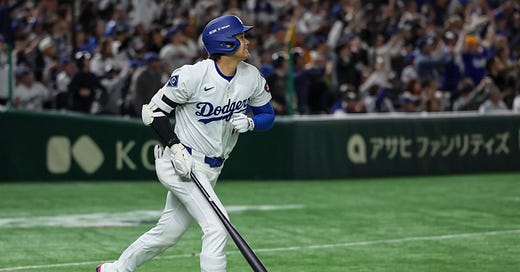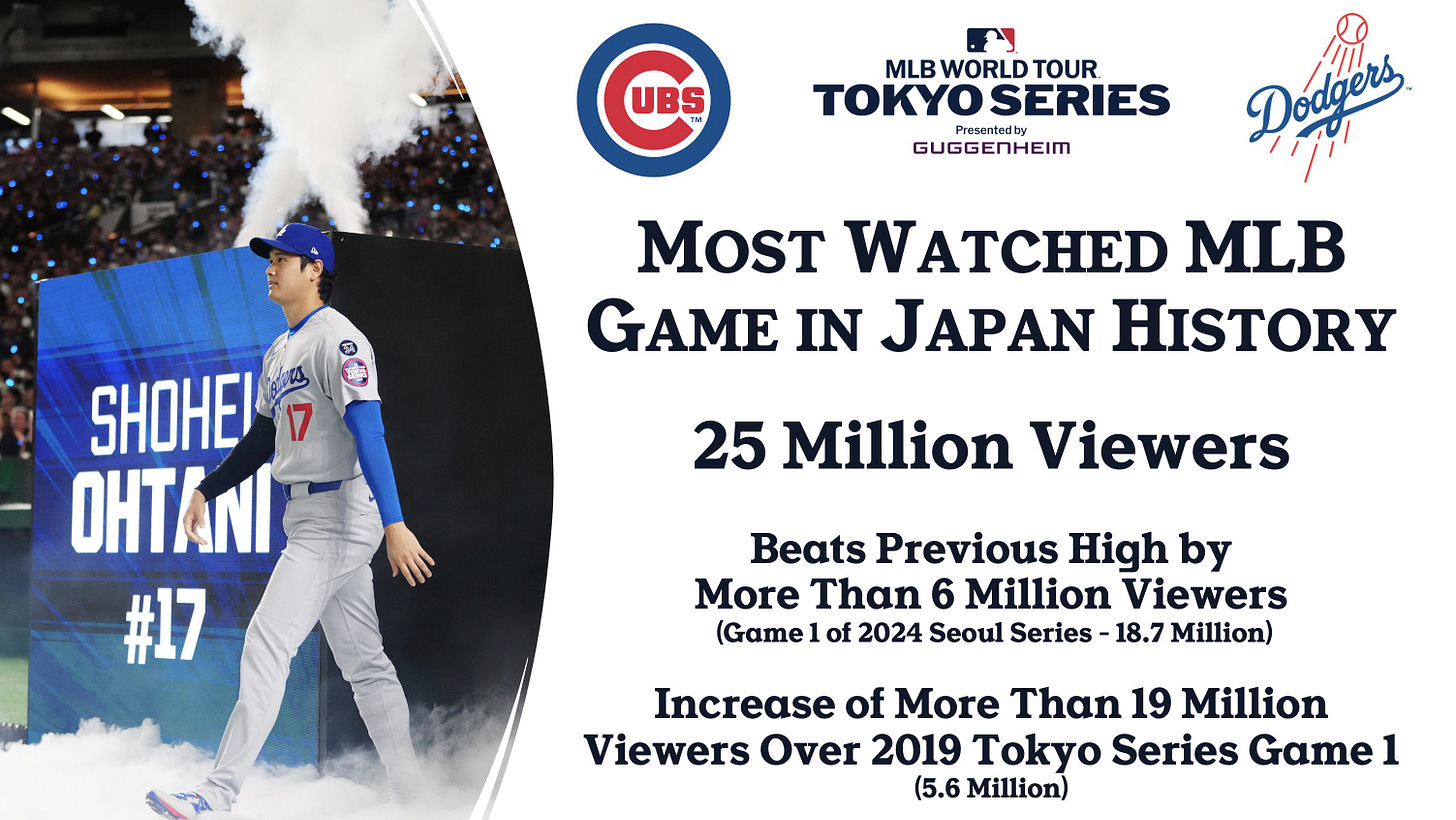This week, the LA Dodgers and Chicago Cubs played the Tokyo Series, the title of which should be pretty self-explanatory. A couple of American teams played in front of fans in Japan. Everybody with me? Nice.
After Game 1, MLB’s PR team put out the following announcement:
What that graphic does not include is the fact that 25 million viewers is more than any MLB game has drawn in America since Game 7 of the 2017 World Series between the Houston Astros and, yup, these Dodgers.
The difference (in more ways than one)? Those Dodgers didn’t have Shohei Ohtani. And again, this is an exhibition game. This isn’t the deciding game of the postseason. It’s (technically) the start of the regular season! Which has, you’ll recall, 162 games! For this to be an event is sorta nuts.
So the immediate takeaway — which kinda feels like an oversimplification, but probably isn’t — is that Japan has a stronger baseball fanbase than the U.S. Is that actually true?
Proportionally, yeah. Japan has about 2.75 times fewer people than America, which makes the 25 million figure above — almost exactly one-fifth of the total population — a little more striking in context.
How did this happen? As with many things: first slowly, then all at once.
MLB’s history in Japan goes back even further, but the Dodgers have a long-running relationship all their own. It dates back to 1956, when the team played a series of exhibition games there following their World Series win in 1955. Baseball was a significant piece of cultural diplomacy between the U.S. and Japan in the aftermath of World War II, building back ties that were, to wildly understate it, a lil frayed in the 40s.
(Also, as an interesting little side note of history, those ended up being the last games Jackie Robinson ever played. He then suddenly retired before the 1956 season. The more you know!)
An influential Japanese journalist named Sotaro Suzuki, who was one of the country’s main ambassadors for baseball, and a leading figure in the continued growth of professional baseball in Japan, became friends with the Dodgers’ owner at the time, Walter O’Malley. He helped set up a goodwill tour a decade later in 1966, and just before that, sent a rather elaborate gift over to O’Malley and the Dodgers. I’ll let O’Malley’s website take over storytime from here:
In the winter of 1965, Suzuki sent a remarkable gift to Dodger President Walter O’Malley of a “Kasuga” stone lantern (8-feet tall and nearly 4,000 pounds), which became the centerpiece of a traditional Japanese garden on the hill beyond right-center field at Dodger Stadium. It was Suzuki’s hope that Dodger fans would appreciate the stone lantern as a symbol of friendship between O’Malley and baseball in Japan.
That helped cement the ties we see alive and well today, and decades later, the Dodgers made their first big signing out of Japan. Hideo Nomo came to LA in 1995 and won Rookie of the Year, leading the league in strikeouts. He never quite matched the heights of his first two years, but he stuck in the majors for a solid decade, and his immediate success set a new standard as to what a Japanese player could do in the majors.
Newly minted Hall of Famer Ichiro Suzuki followed soon after, and somehow found even greater success right away. He won Rookie of the Year too. He just also happened to win MVP in his first year in America. Not bad.
After that, the star power takes a while to ramp back up to those two, but the thing about the Dodgers — and other teams were doing this to some extent too, but the Dodgers more than most — is they kept going back to the well of arm talent in Japan. In the years after Nomo came over, they recruited a number of pitchers, and did so with more success than not.
Kazuhisa Ishii in 2002, Takashi Saito in 2006, Hiroki Kuroda in 2008, Kenta Maeda in 2016. None were full-blown stars, but the Dodgers made clear that they could ably recruit from the ranks of professional baseball in Japan that their old pal Sotaro Suzuki helped support all those years before. Other teams were signing excellent players too, from Hideki Matsui to Daisuke Matsuzaka to Yu Darvish. The talent was there, and had been there, and was starting to move stateside more and more frequently as time went on.
Going back to where we started today, I note with interest the bottom-most figure in that PR graphic above. MLB played a Tokyo series in 2019, too. Back then, just 5.6 million people watched. That’s way more than watch a regular old regular season baseball game in America, to be clear. But this year, 19 million more Japanese fans watched. What changed?
Again, I say: the 2019 Mariners and A’s (who have undergone some… other changes in the last few years) didn’t have Shohei Ohtani.
And while that, too, is an oversimplification — the Dodgers have done an enviable job of recruiting Japanese stars to come play in LA — I do think much of that bump can be attributed to the biggest star in the sport, who happens to be one of the most famous celebrities in all of Japan. People want to watch this guy be amazing, and he is.
I’ve heard people ask how the Dodgers managed to do what the Mariners couldn’t when they had Ichiro, who was — in his home country in Japan — not so far off as a comp to Shohei. The Mariners did sign other Japanese players, like Hisashi Iwakuma and Kazuhiro Sasaki.
The difference is that those guys weren’t the caliber of star that the Dodgers’ newest signings after Shohei — guys like Yoshinobu Yamamato and Roki Sasaki — have already proven to be. Part of that is age.
It’s typically been a pattern for either American or Japanese players to move between the two leagues when they’re either in or a little past their prime playing years. Yoshinobu and Roki are two examples of guys who’ve come over nearer the start of extremely promising careers, betting on themselves that they’d be able to hack it in the majors. So far, so good.
For the Dodgers, this has all been swell. Both Yoshinobu and Ohtani helped them win a title last year, which is great for on the field. But that’s not the only reason they’ve pursued their Japan strategy so aggressively. It pays.
The numbers are a little fuzzy, and subject to some degree of speculation and/or telephone, but my friend
reported that Ohtani was worth $100M to the team last year alone. That comes in the form of Japanese ad sponsors, merchandising, even fans flying in from Japan just to see the guy play.We mentioned the World Series earlier, and another stat from Joe that caught my eye was the strikingly narrow gap between the average number of fans who were watching the series in America — 15.8 million — and those in Japan, 12.1 million. If you’re in Japan, these games were starting at 9:00 in the morning. On weekdays! And yet, 12.1 million people were watching.
That’s what the Dodgers, and baseball, are trying to engage with. The great American pastime has a bright future in Japan, and the Dodgers have assured themselves, with the signing of this young century, that they’ll be leading it.
🏀 I will be the first to admit that this is about as uninformed as I’ve ever started March Madness. I enter into the sacred covenant of the bracket with the full knowledge that I am unprepared. But go Mizzou, I guess? Sure! Go get ‘em, Tigers.
⚾ The private equity firm Sixth Street bought a roughly 10% stake in the San Francisco Giants this week, a fascinating move for a number of reasons. Feel like
would have a take on that one too.🏈 I don’t want to pick on the guy necessarily, but I will say — wasn’t shocked by the Front Office Sports exclusive I saw this week on all the media networks that weren’t interested in putting Aaron Rodgers in the announcers’ booth. You have to figure he’d be good at it, and yet. Maybe not your first choice for the guy you’d want to do a game with. Who knew.
🤝 The NCAA settled a lawsuit with a number of states this week to allow college athletes to negotiate their NIL deals prior to enrolling at a school, a provision that had been in place to avoid “pay-for-play” deals. Or, you know, every deal of consequence. The times sure are a-changin’.
💏 I don’t usually spend a ton of time on celebrity gossip corner, but damn — Ben Shelton and Trinity Rodman? Now there’s an American power couple we can get behind. Lead us into the future, ShelTrin.









I’m in Tokyo now and hate that I couldn’t make it to any of the games. By the time I checked the cheapest ticket was $400 and I’ve only recently started watching baseball.
Is it weird that I kind of like the idea of having baseball on at 9am on weekdays?